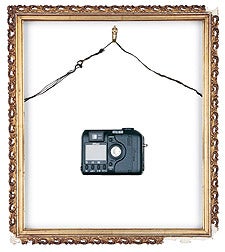ON JOHN WESLEY Powell’S second expedition down the Colorado River, photographer John Hillers’s “film” consisted of cumbersome 9-by-12-inch glass plates. Hillers created peerless images of the epic float through the Grand Canyon and of the Navajo, Hopi, and Ute who inhabited the Colorado Plateau, but he had to set up a tentlike darkroom before each shot and coat each plate with a chemical cocktail of silver nitrate, alcohol, and guncotton. He had no choice, of course—it was 1872. Luckily, you do. Today’s astonishing array of highly portable, top-notch camera equipment means that even a weekend photographer can capture a gallery-quality image. Your only dilemma will be deciding which format fits your style: digital, video, or film. At least Hillers didn’t have to agonize over a dizzying range of glass plates to buy.
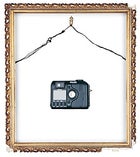
With more than half of all pictures now shot digitally—a fact that has nabobs of negativism signaling film’s death by 2010—the transition to megapixels seems unstoppable. Two-megapixel resolution makes for crisp Web-site photos or e-mailable JPEGs; for prints, you can get away with three megapixels, but you’ll need at least five megapixels if your aim is to rival film’s quality output. And the last barrier to going digital—no-brainer software—appears to have been broken. All the digital cameras reviewed on the following pages come with programs that automatically download your images onto your computer the instant the camera connects to your Mac or PC via a USB port. Add a photo-image printer and you can open your own Photo Bug.
But maybe you’re thinking video. In that case, the new incredible shrinking camcorders combine both snapshot capability and 60 minutes of video in a package that’s smaller than most film cameras. Two years ago, you would’ve paid $3,000 for the features that today’s smaller and more technologically advanced camcorders offer for about a grand.
Still, no matter how wide your technogeek eyes get, film isn’t going away, despite the digerati’s prognostications. Celluloid provides a richness of color and depth that digital cameras can’t yet touch, and the medium continues to handle extremes in contrast and brightness better than its pixelated brethren. Good thing too, since in Cuzco film is eminently easier to find than a Memory Stick.
But before you try to photograph, say a hissing cobra at a bazaar, a few words of advice: When choosing a machine, wrap your hands around it and peer through the viewfinder; it should feel sized just for you, the various controls all naturally under your fingertips. Get the right fit and what you see will be what you’ll get with every snap.
The Olympus E-20N, the Canon Elan 7E, and Nikon’s Coolpix 885
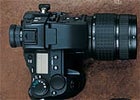
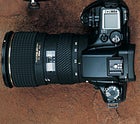
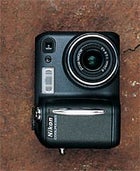
The OLYMPUS E-20N digital camera’s five-megapixel resolution yields tack-sharp 11-by-14 prints, an all-glass 35-140mm zoom lens handles most photo situations superbly, and its true SLR viewfinder ensures WYSIWYG confidence. While neither tiny nor light, the E-20N does feature two thoughtful touches: The LCD panel rotates up and down, allowing you to frame pictures with the camera held overhead or at your knees. And it can store those memory-hungry five-megapixel images on any of three types of storage media: Smart-Media, CompactFlash, or Micro-drive. Note: You will feel like a photojournalist hauling around the E-20N’s sizable and awkward lens. ($1,719*; 800-622-6372, )
The classic 35mm CANON Elan 7E SLR camera ($455; (800-652-2666, ) nestles comfortably in the hand, feeling like it was custom-molded to fit. It helps that its auto-eye-focus control tracks my eye-pupil movements, zeroing in wherever I look with eerie accuracy—useful when the subject is the kayaker flailing in the foreground, not the waterfall behind. And it comes value-packed with a quiet, four-frame-per-second film advance that won’t alarm wildlife, a 1/4,000-second shutter speed that can freeze the motion of a hummingbird’s wings, and tough metal-plate construction that will survive years of abuse. I added a Tokina 28—80mm f/2.8 AT-X 280AF Pro lens ($549; 800-421-1141, ), a super-sharp, quick-focusing wide-angle-to-short-telephoto lens that’s fast enough to shoot in low light.
NIKON’s Coolpix 885 will have even celluloid snobs thinking digital. It’s an easy-to-use 3.2-megapixel camera that rivals 35mm film quality for any enlargement up to 11-by-14. It isn’t as minuscule as Minolta’s DiMAGE X (lower right), but it’s still plenty small, slipping nicely into a cargo-pants pocket and weighing in at eight ounces. The 3:1 Nikkor zoom covers a useful 38-114mm range (wider-angle, fisheye, and telephoto lens attachments are available), and its 12 preprogrammed exposure modes handle anything outside, from sunsets to caving. Or if like me you’re still hands-on, adjust the exposure manually. All in all, a sweet mix of features for the money. ($440; 800-645-6689, )
*Prices reflect street-price quotes from B&H Photo Videos, New York City (800.606.6969).
The Sony DCR1P5, Pentax's IQZoom 95 WR, and Minolta's DiMage X
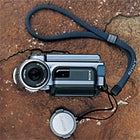
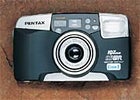
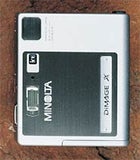
The SONY DCR-IP5 camcorder is so shockingly small and light that when I opened the box, I mistook the camera for the battery. But don’t be misled; this 12-ounce featherweight is a full-fledged camcorder, with a 10:1 Zeiss zoom lens, a swivel-mounted color LCD screen, and an image stabilizer for the overcaffeinated among us. It uses only Sony’s proprietary 60-minute MICROMV tape, but that’s OK. The microcassette records 500 lines of resolution— on par with the larger MiniDV format. Less OK, the camcorder’s tiny size makes it hard to operate with gloves on or cold fingers. But the wow factor with this mighty mite is immense. ($1,200; 800-571-7669, )
Point-and-shoot cameras are almost as generic as compact SUVs, but PENTAX’s IQZoom 95WR is an exception. It’s watertight—ideal for kayakers, skiers, surfers, and others who spend their time near water, liquid or frozen. Mind you, the 95WR is not waterproof, so no diving, but if you drop it in the drink, just wipe it off and go. It even floats. The 38-95mm zoom lens could offer more on the wide-angle side, but it works fine for most of your needs. Pentax’s light meter and autofocus are spot-on for all but the trickiest scenes, and this easiest-to-use marvel uses 35mm film, conveniently available worldwide. ($170; 800-877-0155, )
MINOLTA’s DiMAGE X would qualify as Most Amazing Camera Here were it not for Sony’s camcorder. The DiMAGE X is a two-megapixel digital shooter that’s only 0.8 inches thick, weighs no more than a four-pack of AA batteries, and can slide into a T-shirt pocket. Design legerdemain folds the 3:1 zoom lens inside the camera body—when you zoom out, there’s no Pinocchio-like lens protruding into space. Another surprise: The DiMAGE X fires up extremely fast—1.8 seconds after pushing “on”—so you can snap your picture before it gets away. Alas, the folded lens results in slightly less crisp images than those from bulkier competitors, but the camera’s James Bond elegance and size make it utterly drool-worthy. ($390; 800-964-6658, )
Professional-Grade Accessories, Pt. I
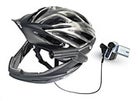

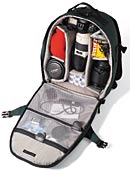
For his latest film, NSX Lights Out, British Columbian filmmaker Todd Fiander clamped VIOSPORT’s Helmet Cam ($150) to the head of teenage fat-tire stunt rider Thomas Vanderham to capture his view of a sickening 30-foot free fall from the top of a Victorian-house-size boulder. Fiander credits the innovators at Viosport with finally producing an affordable, high-quality, portable video system that allowed him to nail this cinematic feat, previously the domain of big-budget thrill productions like the X Games. While not quite waterproof (apologies to those paddlers among us), the Helmet Cam saves wanna-be extreme filmmakers from demolishing pricey electronics should they auger into dirt, snow, or pavement—by keeping the camcorder (not included) protected in a backpack or fanny pack (meaning you can take hands-free video where you never dared before). Simply Velcro the Helmet Cam’s cigar-size, 4.5-ounce lens to your headgear, plug it into your camcorder (we like Sony’s palm-size PC-9 MiniDV, pictured at left, with sound-track dubbing and special-effects package, $1,040), and go. The state-of-the-art lens uses Panasonic image sensors to record broadcast-quality footage, and a no-fuss shutter mechanism keeps the subject in focus while adjusting to changing light conditions. As for durability, Fiander claims, “You could probably drive a car over it and it would be just fine.” (906-226-9393, )
—Dan Oko
Say good-bye to Fotomat. HEWLETT-PACKARD‘s Photosmart 1315 printer ($400) prints photographs on regular paper or high-quality glossy stuff up to 8-by-10, producing a richly colored print that’s hard to differentiate from its lab-produced cousin. Print directly from your computer, or plug a media card into the printer and edit, crop, and retouch photos via the HP’s 2.5 inch LCD panel. It’s a little too easy; ten minutes after opening the box, I was printing glossy enlargements for $1.30 a sheet, 4-by-6’s for half that (paper sold separately through HP). (800-752-0900, ) —D.G.
Last summer while researching a book about forest fires, I hauled a LOWE PRO Mini Trekker pack ($110) all over Idaho. It easily carried cameras, lenses, tape recorders, notebooks—not to mention sandwiches, Snickers bars, and a Gore-Tex jacket. Adjustable padded dividers make it easy to reconfigure the pack for two 35mm camera bodies plus several lenses and a flash, or for a simple camera and a weekend’s worth of gear. Think of it as a sort of infinite-space-making device, with seemingly endless places to store things safely. (800-800-5693, ) —Douglas Gantenbein
Professional-Grade Accessories, Pt. II
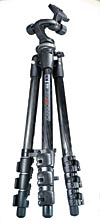
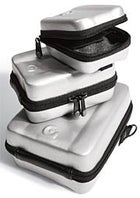
Everybody’s photography benefits from the firm support of a tripod, particularly for dawn, dusk, and night shots that require slower shutter speeds. BOGEN‘s 3443D carbon-fiber tripod gives you both a solid base and a light load. It weighs 3.5 pounds, about two-thirds the heft of an aluminum tripod, and the carbon-fiber construction ensures that it’ll survive, say, a fall off Half Dome—although at this price ($312), you may opt to follow it down. Add a 3437 magnesium head ($79) with a quick-release plate that stays attached to the camera and clips in seconds to the tripod. (201-818-9500, ) —D.G.
Leave it to GRAVIS, the stylish footwear and accessories spin-off of Burton Snowboards, to rethink the lowly camera case. Its Cell Blocks ($10-$20) come in three sizes and use lightweight compression-molded foam to protect anything from a cigarette-pack-size APS camera to a handheld digital camcorder, all in silver-colored cases that look like a leftover props from Woody Allen’s Sleeper. Space-age bulbosity aside, these Blocks will make tossing costly electronics back and forth over a crevasse a little less stressful. (802-660-7900, ) —D.G.

